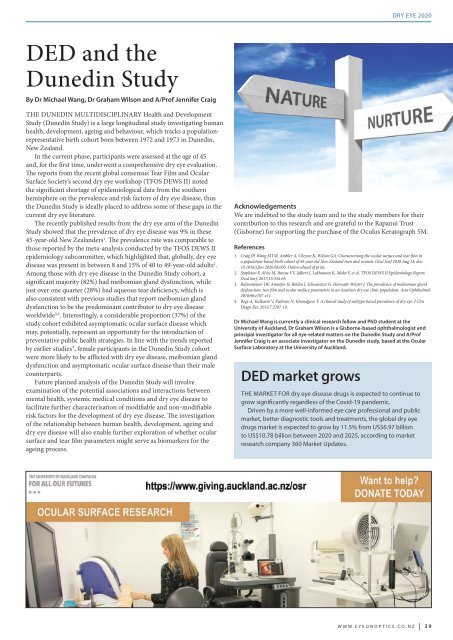Create successful ePaper yourself
Turn your PDF publications into a flip-book with our unique Google optimized e-Paper software.
DRY EYE <strong>2020</strong><br />
DED and the<br />
Dunedin Study<br />
By Dr Michael Wang, Dr Graham Wilson and A/Prof Jennifer Craig<br />
THE DUNEDIN MULTIDISCIPLINARY Health and Development<br />
Study (Dunedin Study) is a large longitudinal study investigating human<br />
health, development, ageing and behaviour, which tracks a populationrepresentative<br />
birth cohort born between 1972 and 1973 in Dunedin,<br />
New Zealand.<br />
In the current phase, participants were assessed at the age of 45<br />
and, for the first time, underwent a comprehensive dry eye evaluation.<br />
The reports from the recent global consensus Tear Film and Ocular<br />
Surface Society’s second dry eye workshop (TFOS DEWS II) noted<br />
the significant shortage of epidemiological data from the southern<br />
hemisphere on the prevalence and risk factors of dry eye disease, thus<br />
the Dunedin Study is ideally placed to address some of these gaps in the<br />
current dry eye literature.<br />
The recently published results from the dry eye arm of the Dunedin<br />
Study showed that the prevalence of dry eye disease was 9% in these<br />
45-year-old New Zealanders 1 . The prevalence rate was comparable to<br />
those reported by the meta-analysis conducted by the TFOS DEWS II<br />
epidemiology subcommittee, which highlighted that, globally, dry eye<br />
disease was present in between 8 and 15% of 40 to 49-year-old adults 2 .<br />
Among those with dry eye disease in the Dunedin Study cohort, a<br />
significant majority (82%) had meibomian gland dysfunction, while<br />
just over one quarter (28%) had aqueous tear deficiency, which is<br />
also consistent with previous studies that report meibomian gland<br />
dysfunction to be the predominant contributor to dry eye disease<br />
worldwide 3,4 . Interestingly, a considerable proportion (37%) of the<br />
study cohort exhibited asymptomatic ocular surface disease which<br />
may, potentially, represent an opportunity for the introduction of<br />
preventative public health strategies. In line with the trends reported<br />
by earlier studies¹, female participants in the Dunedin Study cohort<br />
were more likely to be afflicted with dry eye disease, meibomian gland<br />
dysfunction and asymptomatic ocular surface disease than their male<br />
counterparts.<br />
Future planned analysis of the Dunedin Study will involve<br />
examination of the potential associations and interactions between<br />
mental health, systemic medical conditions and dry eye disease to<br />
facilitate further characterisation of modifiable and non-modifiable<br />
risk factors for the development of dry eye disease. The investigation<br />
of the relationship between human health, development, ageing and<br />
dry eye disease will also enable further exploration of whether ocular<br />
surface and tear film parameters might serve as biomarkers for the<br />
ageing process.<br />
Acknowledgements<br />
We are indebted to the study team and to the study members for their<br />
contribution to this research and are grateful to the Rapanui Trust<br />
(Gisborne) for supporting the purchase of the Oculus Keratograph 5M.<br />
References<br />
1. Craig JP, Wang MTM, Ambler A, Cheyne K, Wilson GA. Characterising the ocular surface and tear film in<br />
a population-based birth cohort of 45-year old New Zealand men and women. Ocul Surf <strong>2020</strong> Aug 13; doi:<br />
10.1016/j.jtos.<strong>2020</strong>.08.005. Online ahead of print.<br />
2. Stapleton F, Alves M, Bunya VY, Jalbert I, Lekhanont K, Malet F, et al. TFOS DEWS II Epidemiology Report.<br />
Ocul Surf. 2017;15:334-65.<br />
3. Rabensteiner DF, Aminfar H, Boldin I, Schwantzer G, Horwath-Winter J. The prevalence of meibomian gland<br />
dysfunction, tear film and ocular surface parameters in an Austrian dry eye clinic population. Acta Ophthalmol.<br />
2018;96:e707-e11.<br />
4. Rege A, Kulkarni V, Puthran N, Khandgave T. A clinical study of subtype-based prevalence of dry eye. J Clin<br />
Diagn Res. 2013;7:2207-10.<br />
Dr Michael Wang is currently a clinical research fellow and PhD student at the<br />
University of Auckland, Dr Graham Wilson is a Gisborne-based ophthalmologist and<br />
principal investigator for all eye-related matters on the Dunedin Study and A/Prof<br />
Jennifer Craig is an associate investigator on the Dunedin study, based at the Ocular<br />
Surface Laboratory at the University of Auckland.<br />
DED market grows<br />
THE MARKET FOR dry eye disease drugs is expected to continue to<br />
grow significantly regardless of the Covid-19 pandemic.<br />
Driven by a more well-informed eye care professional and public<br />
market, better diagnostic tools and treatments, the global dry eye<br />
drugs market is expected to grow by 11.5% from US$6.97 billion<br />
to US$10.78 billion between <strong>2020</strong> and 2025, according to market<br />
research company 360 Market Updates.<br />
WWW.EYEONOPTICS.CO.NZ | 39

















